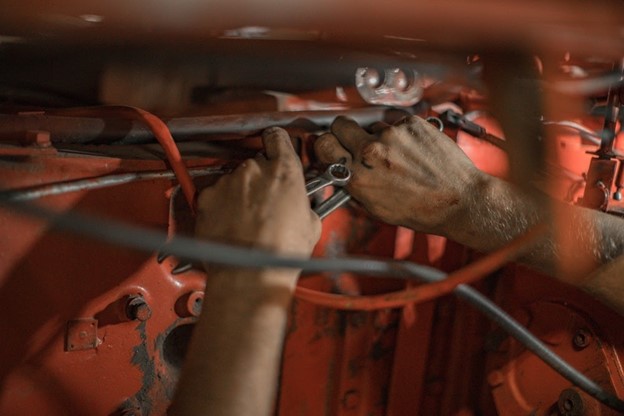Conveyor Belt Maintenance: The Most Common Conveyor Belt Problems and Solutions
As one of the most popular and flexibly used pieces of equipment across all production levels, conveyor belts are bound to face some issues from time to time. Moving parts break and conveyor belts, no matter how well-serviced, will face issues like blockage, material spillage, mistracking, belt slippage and seized rollers.
Many times knowing what to look for is only half the battle, so we’ll be highlighting some of the most common problems faced with conveyor belt equipment and how to troubleshoot and prevent them.
Relieving Conveyor Belt Blockages
What Causes Conveyor Belt Blockages?
Conveyor belts can handle the transportation of equipment from point A to point B, but sometimes there are disruptions along the path due to various circumstances. Blockages are among the most prevalent reasons why conveyor belts simply stop moving. Material can easily get caught in the gears or along the belt pathway causing blockages of all shapes and sizes. Small bits of materials result in buildup leading to a clogged and jammed system. Big pieces of material are much easier to spot but can often cause the biggest issues.
How To Avoid Conveyor Belt Blockages
While some of these belt blockage issues are not always preventable, keeping a well maintained machine can help curb these occurrences and even help you avoid a domino effect of problems across the entire industrial system. Start by checking your conveyor belt equipment for any weak points, holes or sharp edges that could potentially create blockages. Be sure to repair them as soon as they are identified to help prevent materials snagging, depositing or creating blockage across your conveyor paths.
Handling Conveyor Belt Material Spillage
What Causes Material Spillage on a Conveyor Belt?
Causing a spillage when transporting equipment is inevitable and bound to happen. So, when preventing is not a viable option, what’s the best course of action? It is important to understand ‘why’ it happens. Material can accidentally slide, roll or spill over into your conveyor belt. The better you can secure any product moving along your belt, the less spillage you can expect.

People inspecting bottles on a conveyor belt
If you have been noticing an abundance of spillage incidents across parts of your conveyor, you may need to look at your pathway to adjust areas that may be causing excess motion such as rattling or shaking. Install some impact beds, skirt clamps or a belt plough depending on your specific need. These solutions can help you save time (and money) by avoiding the need for extra material spillage cleaning and reduce your waste overall. Do not forget to clean your machine regularly to ensure optimum performance.
Adjusting a Mistracked Conveyor Belt
What Causes Conveyor Belt Mistracking?
When belts are not aligning onto the correct path, you are bound to end up with a mistracked conveyor. These types of issues arise because of inspection and adjustments not being made on a regular basis. It is mission critical to ensure that your belt is aligned and functioning as smoothly as possible. Mistracking arises when your belt has moved too far to one side or another causing the entire system to shift out of its intended alignment.

How To Prevent Conveyor Belt Mistracking
Not only does mistracking throw off the entire system, there are a slew of issues that can arise such as uneven belt wear, spillage and more. The best way to prevent a mistracked conveyor is to ensure you are keeping a close eye on every piece of equipment and tracking its performance closely. Look out for small signs of misalignment and address them immediately as they arise to avoid larger problems in the long term.
Fixing Belt Slippage
What Causes Slippage In Conveyor Belts?
What is a conveyor without a belt? Belt slippage is also a commonly occurring problem that can arise with your equipment. Generally, this issue presents itself when there’s poorly balanced tension – too much or too little can cause the belts to slip off the rest of the machine causing major issues and with it, downtime.
Conveyors work on a pulley system, so belt slippage can quickly lead to the overuse of head pulleys which can even result in broken equipment. Loss of tension can also cause loud rattling, grating and screeching noises. It can also affect your belt by unnecessarily stretching or warping it causing strain on the rest of your equipment.
How To Prevent Belt Slippage
To avoid this issue, check all parts of your equipment regularly. Calibrate your belts for optimal tension and keep a log of your measurements to ensure your belt hasn’t developed new issues. Slippage problems are among the most time-consuming maintenance issues that arise and result in long periods of downtime.
Resetting Seized Rollers
What Causes Seized Rollers On A Conveyor Belt
Many conveyors are built from metallic materials such as metal and stainless steel making them heavy duty and long lasting. However, these metal rollers used to propel the belts movement can often begin to develop sharp edges that cause snags and can eventually seize the movement of your rollers. This quickly causes a chain reaction across all systems that must be addressed quickly before additional issues arise. Not only do seized rollers bring your production to a halt, but they can also pose a hazard to employees working near your equipment.

How to prevent seized rollers
The best way to prevent the resetting of seized rollers is to visually – and carefully – inspect them on a regular basis. We recommend appointing a member of your team to perform regularly scheduled maintenance on all of your conveyor equipment paying very close attention to the roller and belt systems.
JHFOSTER: Conveyor Belt Expertise
JHFOSTER is your ultimate source for help with conveyor belts. Whether your conveyor belt is damaged or broken, or you’re looking for guidance in maintaining your belt to avoid issues, our team has the experience and knowledge to help. Looking for a new conveyor belt solution? Find out what conveyor system works best for your needs by contacting us via phone or email.
